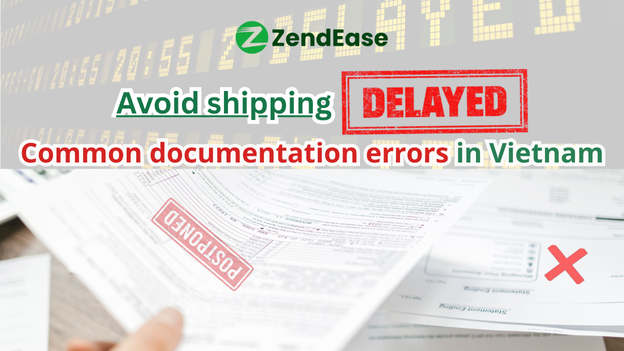Avoiding Shipping Delays: Common Documentation Errors in Vietnam
by Ly Nguyen on Sep 02, 2025

In global trade, timing is everything. A single late shipment can strain customer relationships, reduce competitiveness, and lead to costly penalties. For exporters in Vietnam, one of the biggest culprits behind delays is not transportation, but documentation errors. The paperwork that accompanies goods is what customs officials depend on to verify compliance — and even small mistakes can result in serious setbacks.
This article takes a closer look at the most common documentation errors exporters face in Vietnam, the consequences they bring, and the best practices to avoid them.
Commercial Invoice & Packing List
The commercial invoice and packing list are two of the most fundamental documents in shipping. They must align in every detail: product descriptions, HS codes, quantities, unit prices, gross/net weights, and packaging details. Customs officials compare these documents closely; any inconsistency can raise red flags.
For example, if the invoice states 1,000 units but the packing list shows 950, the shipment is likely to be held until clarification is provided. Even a small typo can cause unnecessary questioning.
Best practice: Standardize your invoicing and packing procedures. Always double-check item descriptions and HS codes, and ensure all numerical details match.
Certificate of Origin (C/O)
The Certificate of Origin is especially important for exporters who want to take advantage of preferential tariffs under trade agreements. Vietnam participates in multiple free trade agreements, and each may require a different form, such as Form D (ATIGA) or Form E (ASEAN-China FTA).
Common mistakes include using the wrong form, leaving required fields blank, or submitting the C/O too late. The consequences can be costly: shipments may lose tariff benefits, forcing buyers to pay higher import duties, or be delayed while customs verifies origin.
Best practice: Identify early which trade agreement applies to your shipment. Prepare and submit the C/O on time, and verify that all information matches the invoice and packing list.
Bill of Lading
The Bill of Lading is both a receipt for cargo and a key transport document. It must be consistent with other shipping documents, particularly the invoice and packing list. Discrepancies in consignee details, product descriptions, or shipment dates often trigger customs inspections.
For example, if the consignee’s address differs slightly between documents, customs may suspect misdeclaration. Even when the difference is unintentional, it can still delay clearance.
Best practice: Treat the Bill of Lading as the “master” document and align all other paperwork to it. Ensure that shipper, consignee, and cargo details are consistent across every form.
Specialized Permits and Licenses
Certain categories of goods require government-issued permits before they can be exported or imported. Common examples include food products, cosmetics, pharmaceuticals, and used machinery. Forgetting to secure these permits — or assuming they are not required — almost always results in delays at the port.
Best practice: Check regulatory requirements early in the export process. Engage with relevant ministries or agencies in advance, as obtaining permits can take time.
Translation and Legalization Errors
Vietnam’s export documents may need to be translated into foreign languages, while some import markets require notarized or legalized translations of Vietnamese documents. Errors here are less common but can be equally disruptive. A poor translation of a technical description or missing consular legalization can make documents invalid.
Best practice: Work with certified translators for important documents, and verify if legalization or notarization is required for your destination market.
The Cost of Mistakes
Documentation errors carry real consequences:
- Goods held at the port, leading to demurrage and storage fees
- Delayed deliveries, potentially breaching contractual obligations
- Loss of tariff benefits, increasing costs for importers
- Damage to reputation and reduced trust with overseas partners
These are not minor inconveniences — they can impact profitability and long-term business relationships.
Final Thoughts
Exporting from Vietnam comes with great opportunities, but also responsibilities. While logistics challenges can sometimes be beyond control, documentation is fully within the exporter’s power. Careful preparation, attention to detail, and adherence to regulatory requirements are key to avoiding shipping delays.
By building stronger documentation practices, exporters can not only save time and money but also strengthen their credibility in the eyes of global partners. In international trade, accuracy in paperwork is more than a formality — it’s a competitive advantage.